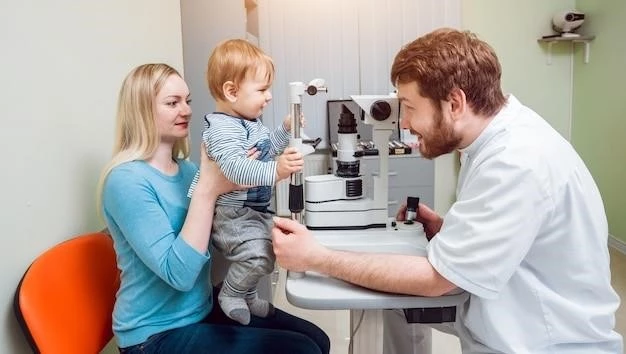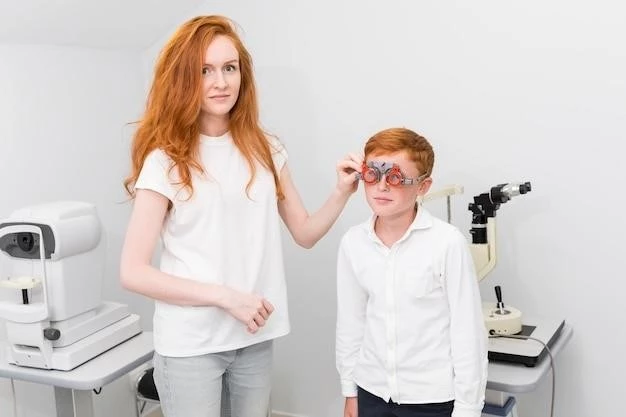Optic nerve hypoplasia is characterized by a decreased number of optic nerve axons and inherited in an autosomal dominant pattern․
Optic nerve hypoplasia (ONH) is a congenital condition characterized by underdevelopment of the optic nerve, leading to decreased vision․ It can affect one or both eyes and is often associated with other ocular, cranial, or facial abnormalities․ In familial cases, ONH is inherited in an autosomal dominant pattern, with mutations in the PAX6 gene implicated in its development․ The condition may present challenges in visual function and quality of life for affected individuals․
Definition and Characteristics
Optic nerve hypoplasia (ONH) is a congenital condition characterized by underdevelopment of the optic nerve, leading to decreased vision․ It can affect one or both eyes and is often associated with other ocular, cranial, or facial abnormalities․ In familial cases, ONH is inherited in an autosomal dominant pattern, with mutations in the PAX6 gene implicated in its development․ The condition may present challenges in visual function and quality of life for affected individuals․
Autosomal Dominant Inheritance Pattern
Bilateral optic nerve hypoplasia is inherited in an autosomal dominant pattern based on the few families reported․ Mutations in the PAX6 (11q13) gene are responsible․ It may present challenges in visual function and quality of life․
Mutations in the PAX6 Gene
Genetic mutations in the PAX6 gene located on chromosome 11q13 have been identified as a key factor in the development of bilateral optic nerve hypoplasia․ Studies suggest a link between PAX6 mutations and the manifestation of this condition in affected individuals․
Optic nerve hypoplasia is associated with risk factors like young maternal age, maternal diabetes, preterm labor, and low maternal weight gain․ Maternal drug usage during pregnancy may also contribute to the condition․
Maternal Age and Diabetes
Optic nerve hypoplasia is associated with risk factors like young maternal age, maternal diabetes, preterm labor, and low maternal weight gain․ Maternal drug usage during pregnancy may also contribute to the condition․
Pregnancy-related Factors
Optic nerve hypoplasia risk factors include maternal age, diabetes, preterm labor, primiparity, low maternal weight gain, and drug usage during pregnancy․ These factors could contribute to the development of the condition․
Clinical Presentation of Bilateral Optic Nerve Hypoplasia
Bilateral optic nerve hypoplasia can present with ocular abnormalities such as microphthalmos, aniridia, and cranial/facial anomalies like midline brain abnormalities․ It may also involve nystagmus and strabismus;
Ocular Abnormalities
Bilateral optic nerve hypoplasia may present with ocular abnormalities like microphthalmos, aniridia, coloboma, nystagmus, and strabismus․ These ocular anomalies often coexist with cranial and facial abnormalities in affected individuals․
Cranial and Facial Anomalies
In addition to ocular abnormalities, bilateral optic nerve hypoplasia may also present with cranial and facial anomalies such as midline brain abnormalities, anencephaly, agenesis of septum pellucidum, and other midline brain defects․ These anomalies may coexist with the ocular manifestations of the condition․

Differential Diagnosis and Related Conditions
Conditions like septooptic dysplasia and de Morsier syndrome share similarities with bilateral optic nerve hypoplasia, presenting a spectrum of ocular, cranial, and facial abnormalities alongside optic nerve underdevelopment․
Septooptic Dysplasia
Septooptic dysplasia, a disorder with similarities to bilateral optic nerve hypoplasia, involves CNS and endocrinological abnormalities linked to mutations in the HESX1 gene․ Both conditions present a range of ocular and craniofacial anomalies․
De Morsier Syndrome
De Morsier syndrome, characterized by optic nerve hypoplasia and pituitary gland abnormalities, shares similarities with bilateral optic nerve hypoplasia․ The syndrome presents a triad of optic nerve underdevelopment, pituitary abnormalities, and midline brain defects․
Molecular Diagnostic Technologies
Advances in molecular diagnostic technologies have enabled the identification of genetic causes of familial bilateral optic nerve hypoplasia, particularly de novo mutations, enhancing our understanding of the condition․
Management of familial bilateral optic nerve hypoplasia involves a multidisciplinary approach focusing on visual rehabilitation, supportive care, and addressing associated anomalies․ Treatment strategies aim to optimize visual function and enhance the quality of life for affected individuals․
Treatment Strategies
Management of familial bilateral optic nerve hypoplasia involves a multidisciplinary approach focusing on visual rehabilitation, supportive care, and addressing associated anomalies․ Treatment strategies aim to optimize visual function and enhance the quality of life for affected individuals․
Research and Studies on Optic Nerve Hypoplasia, Familial Bilateral
Studies on bilateral optic nerve hypoplasia focus on understanding genetic mutations, associated risk factors, and potential treatment strategies․ Research aims to enhance knowledge and improve outcomes for affected individuals․
Current Understanding and Knowledge Gaps
Current research on familial bilateral optic nerve hypoplasia aims to enhance our understanding of the genetic mutations and associated risk factors․ Despite advancements, there are still knowledge gaps that necessitate further investigation to improve diagnosis, management, and outcomes for individuals with this condition․
Genetic Studies and Clinical Trials
Current genetic studies and ongoing clinical trials aim to further investigate the underlying genetic mutations associated with familial bilateral optic nerve hypoplasia․ These research efforts contribute to advancing diagnostic approaches and potential therapeutic interventions for affected individuals․
Impact of Optic Nerve Hypoplasia, Familial Bilateral on Vision and Quality of Life
Optic nerve hypoplasia can result in varying degrees of visual impairment and functional challenges, impacting the quality of life of affected individuals․ Supportive care and rehabilitation play a crucial role in optimizing visual outcomes and enhancing overall well-being․
Visual Impairment and Functional Vision
Individuals with familial bilateral optic nerve hypoplasia experience varying degrees of visual impairment, which can impact their functional vision․ Supportive care and rehabilitation play crucial roles in maximizing visual potential and improving quality of life․
Supportive Care and Rehabilitation
Individuals with familial bilateral optic nerve hypoplasia may benefit from supportive care services and rehabilitation programs aimed at optimizing visual function, enhancing independence, and improving overall quality of life․

Conclusion and Future Directions in Familial Bilateral Optic Nerve Hypoplasia Research
Research on familial bilateral optic nerve hypoplasia continues to focus on understanding genetic mutations, risk factors, and treatment strategies․ Future studies aim to bridge knowledge gaps, improve diagnostic tools, and develop targeted interventions to enhance the management and outcomes for individuals affected by this condition․
